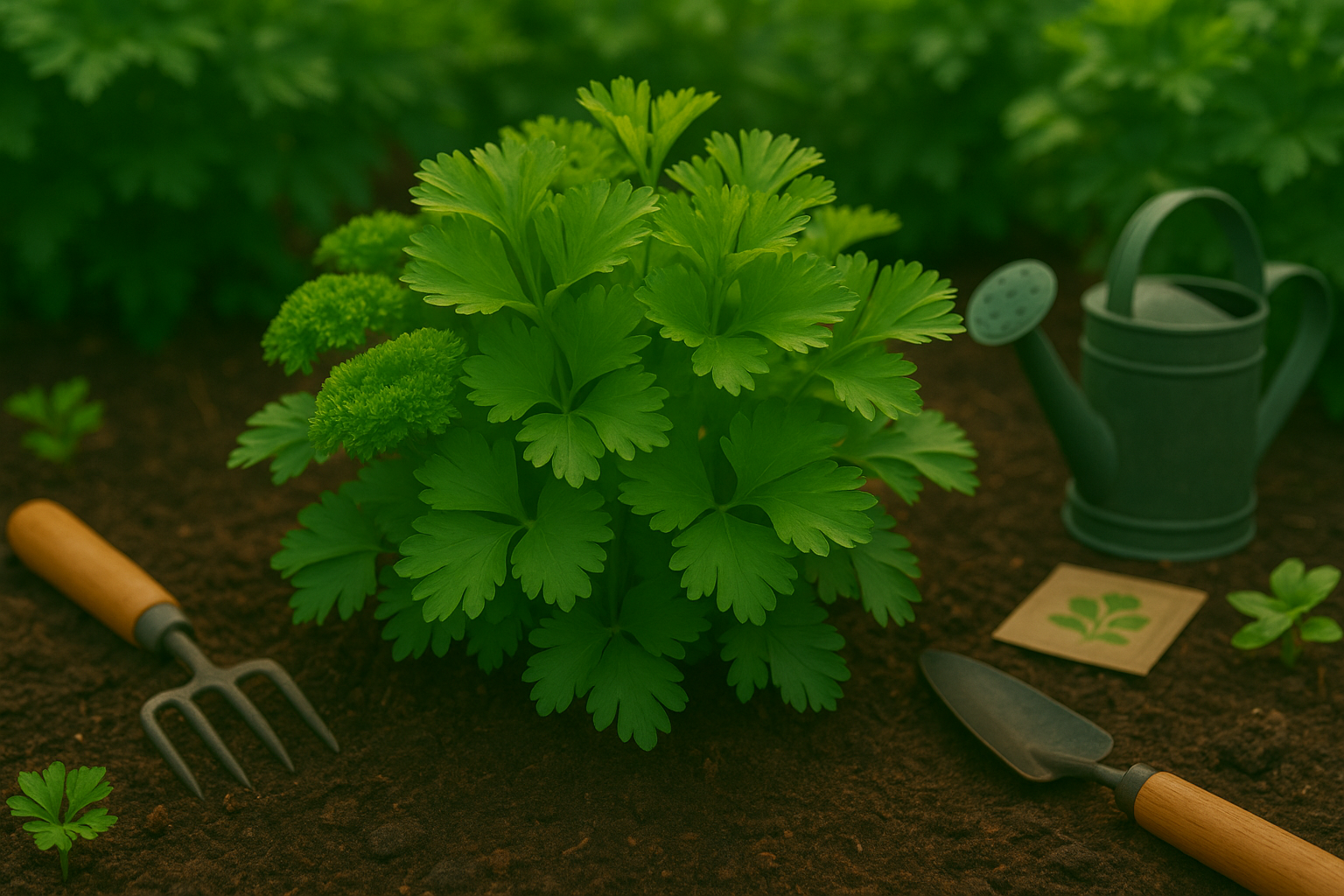Understanding Common Parsley Growing Problems
Parsley is a hardy herb that thrives in most gardens, but even the healthiest plants can face a few common growing issues. One typical problem gardeners notice is yellowing leaves, which often indicates overwatering, poor soil drainage, or sometimes a lack of nutrients like nitrogen.
Wilting, on the other hand, can result from both underwatering and root rot caused by excess moisture, so it’s important to check the soil before adding water. Stunted growth is another frequent concern, usually caused by overcrowded plants, compacted soil, or insufficient sunlight—remember, parsley needs space and at least six hours of sun daily to flourish.
Healthy parsley should have vibrant, deep green leaves, upright stems, and a lush, bushy appearance. If your plant looks pale, droopy, or sparse, it’s time to reassess its care and environment.
For example, thinning seedlings or loosening compacted soil with a hand fork can give roots room to expand, while mulching helps retain moisture without waterlogging the roots. By regularly checking your parsley and addressing these problems early, you can keep your herb patch healthy and productive all season long.
Yellow Leaves on Parsley – Causes and Solutions
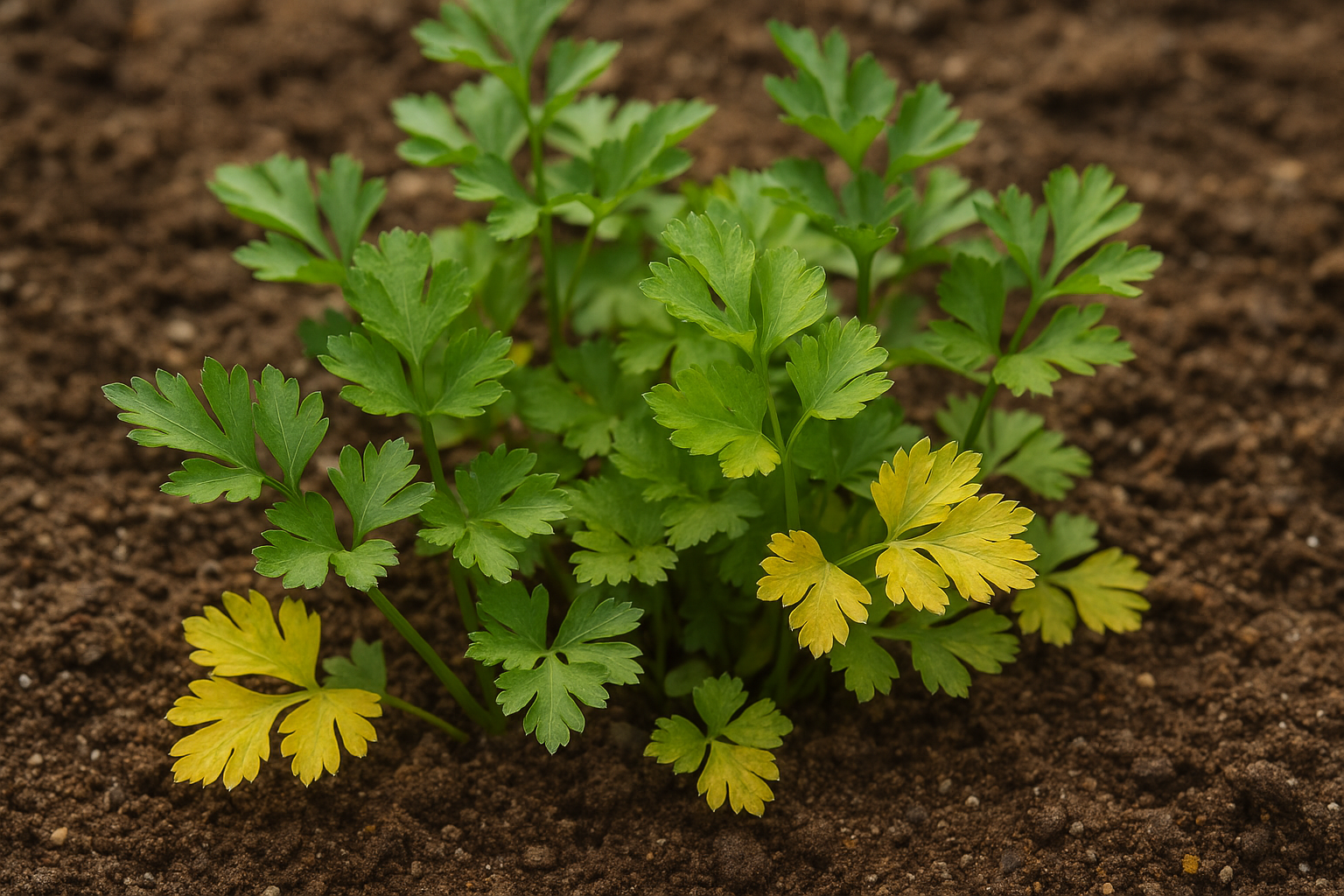
Yellow leaves on parsley can be a common frustration for gardeners, often indicating that something is off with your plant’s care. Overwatering is a major culprit—parsley roots need oxygen, and if the soil is constantly soggy, root rot can develop, leading to yellowing leaves. On the other hand, underwatering also stresses the plant, especially in hot conditions, causing leaves to dry out and turn yellow.
Poor drainage makes both problems worse; waterlogged roots are just as harmful as dry ones. Nutrient deficiencies are another key cause, particularly a lack of nitrogen, magnesium, or iron—these nutrients are essential for the rich green color of healthy foliage. When your soil doesn’t provide enough of these, leaves often start turning pale or yellow, usually from the bottom up.
Environmental stresses can also trigger yellowing: sudden chills, intense sun, or the shock of moving a plant can cause parsley leaves to discolor. The good news is that you can usually nurse your plant back to health by following a few simple steps.
How to Help Your Parsley Thrive
- Check that your parsley is not sitting in soggy or completely dry soil. Water consistently, allowing the top inch of soil to dry out between waterings.
- Improve soil drainage by mixing in compost or sand if your soil is heavy.
- Consider a soil test to identify any nutrient deficiencies, and fertilize as needed with a balanced blend, focusing on nitrogen-rich fertilizers if your plant’s color is fading.
- Protect parsley from extreme weather and ease it into new locations gradually to help it adapt without stress.
By making these adjustments, you’ll encourage lush, green growth and keep your parsley thriving.
Wilting Parsley – Diagnosis and Fixes
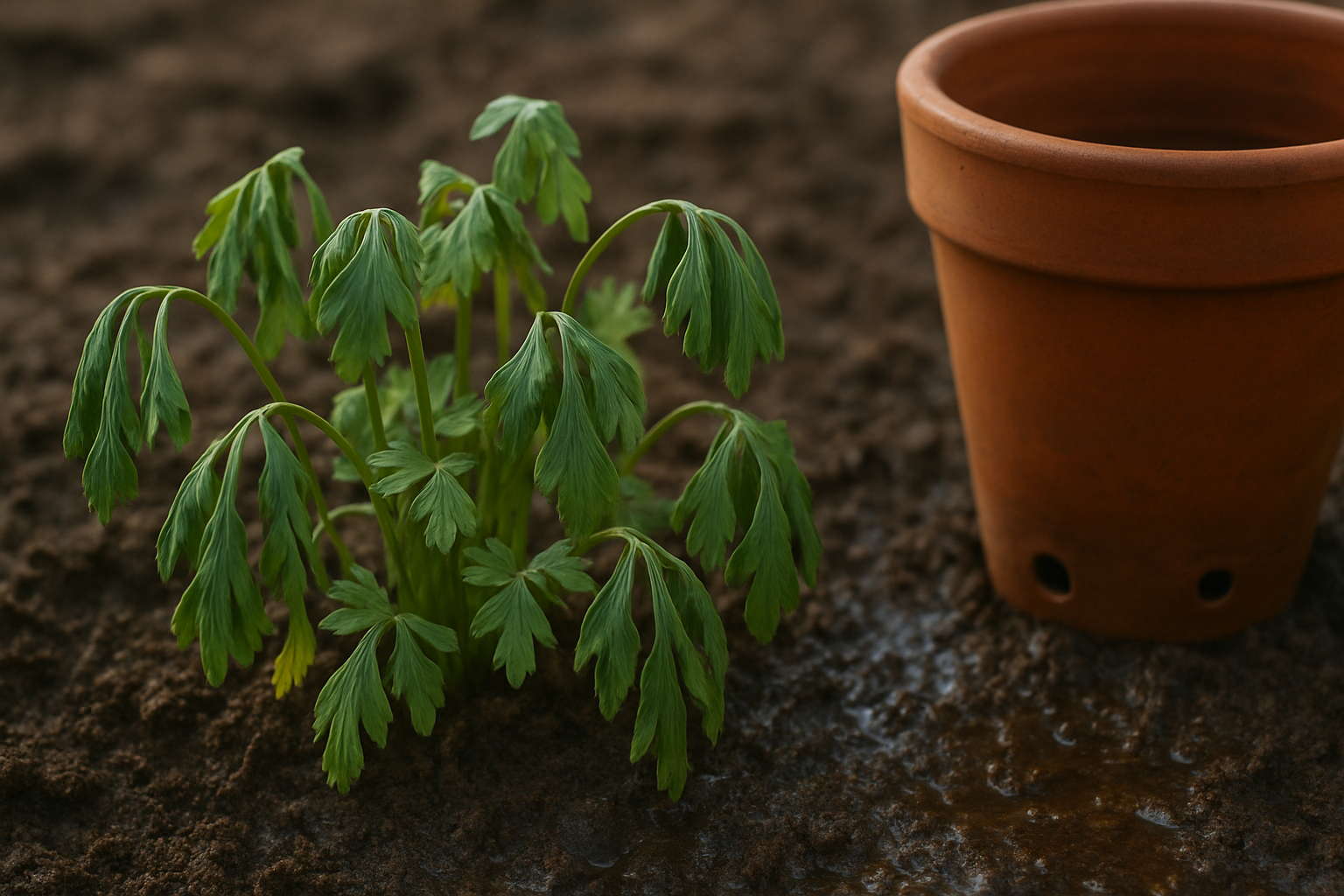
Wilting parsley often signals trouble at the roots, with excess moisture and fungal diseases like root rot being common culprits. Root rot occurs when parsley sits in soggy soil, depriving roots of oxygen and allowing harmful fungi to thrive—leaves droop and yellow, and roots appear brown or mushy.
However, wilting isn’t always caused by overwatering; underwatering or heat stress can produce similar symptoms, with leaves becoming limp and dry during hot spells or if the soil dries out completely.
To pinpoint the issue, press your finger an inch into the soil:
- If it feels wet, drainage is likely a problem.
- If it’s bone-dry, it’s time to water.
For potted parsley, always use pots with drainage holes and avoid letting water pool in saucers. Water deeply but only when the top inch of soil feels dry, and discard any excess runoff.
Outdoors, ensure that beds or containers aren’t sitting in low spots and that the soil drains freely. In hot weather, watering in the morning and providing afternoon shade can help parsley recover.
Routinely check for yellowing foliage and remove any mushy roots, which might save the plant if caught early. Good garden hygiene and attentive watering habits keep parsley lively and lush.
Pests and Disease
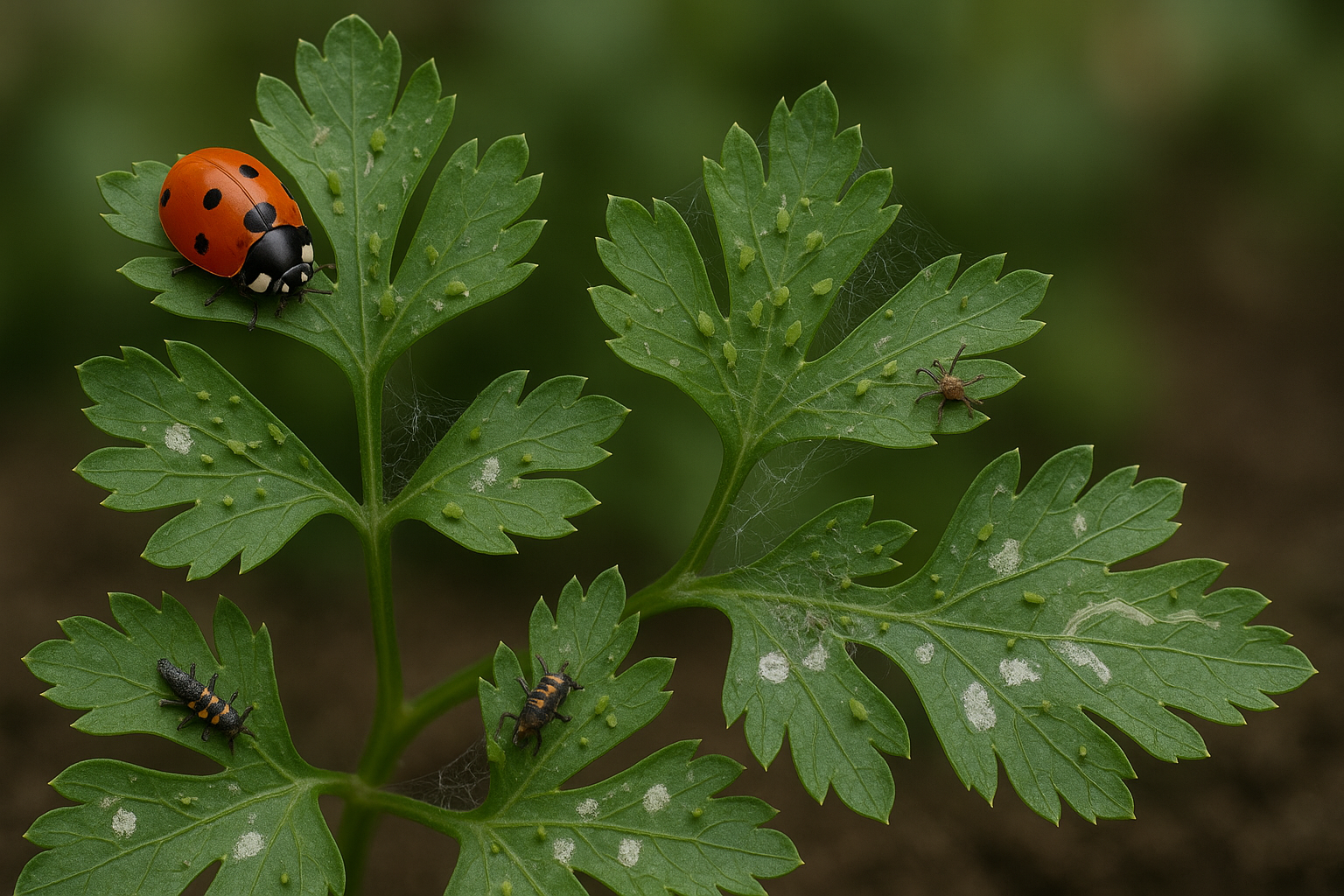
Parsley is a hardy herb, but it’s not immune to unwelcome pests and diseases. Common pests include aphids, which leave sticky residue and curled leaves; spider mites that create tiny webs and cause stippling or yellowing; carrot flies whose larvae tunnel through roots and stunt growth; and leaf miners that burrow between leaf layers, making winding white trails.
Besides pests, parsley can also fall victim to diseases like powdery mildew, seen as a white, powdery coating on leaves; leaf spot, which causes dark, round spots and eventually leads to leaf drop; and damping off, a fungal issue that attacks young seedlings, causing stems to shrivel and collapse.
Combat these threats organically by starting with prevention—space plants well for good airflow and choose disease-resistant seeds when possible. Regularly inspect parsley for early signs of trouble, removing and discarding affected leaves before infestations spread. Introduce beneficial insects such as ladybugs to help control aphids naturally.
If pests persist, spray plants with insecticidal soap, focusing on the undersides of leaves where pests often hide. Keep your garden clean by removing debris and weeds that harbor pests. Rotate crops each year to prevent diseases from building up in the soil. Water at the base of the plant in the morning to minimize humidity and fungal issues.
With consistent monitoring and these organic strategies, you’ll keep parsley healthy and thriving without relying on harsh chemicals.
Environmental Conditions – Location, Light, and Airflow
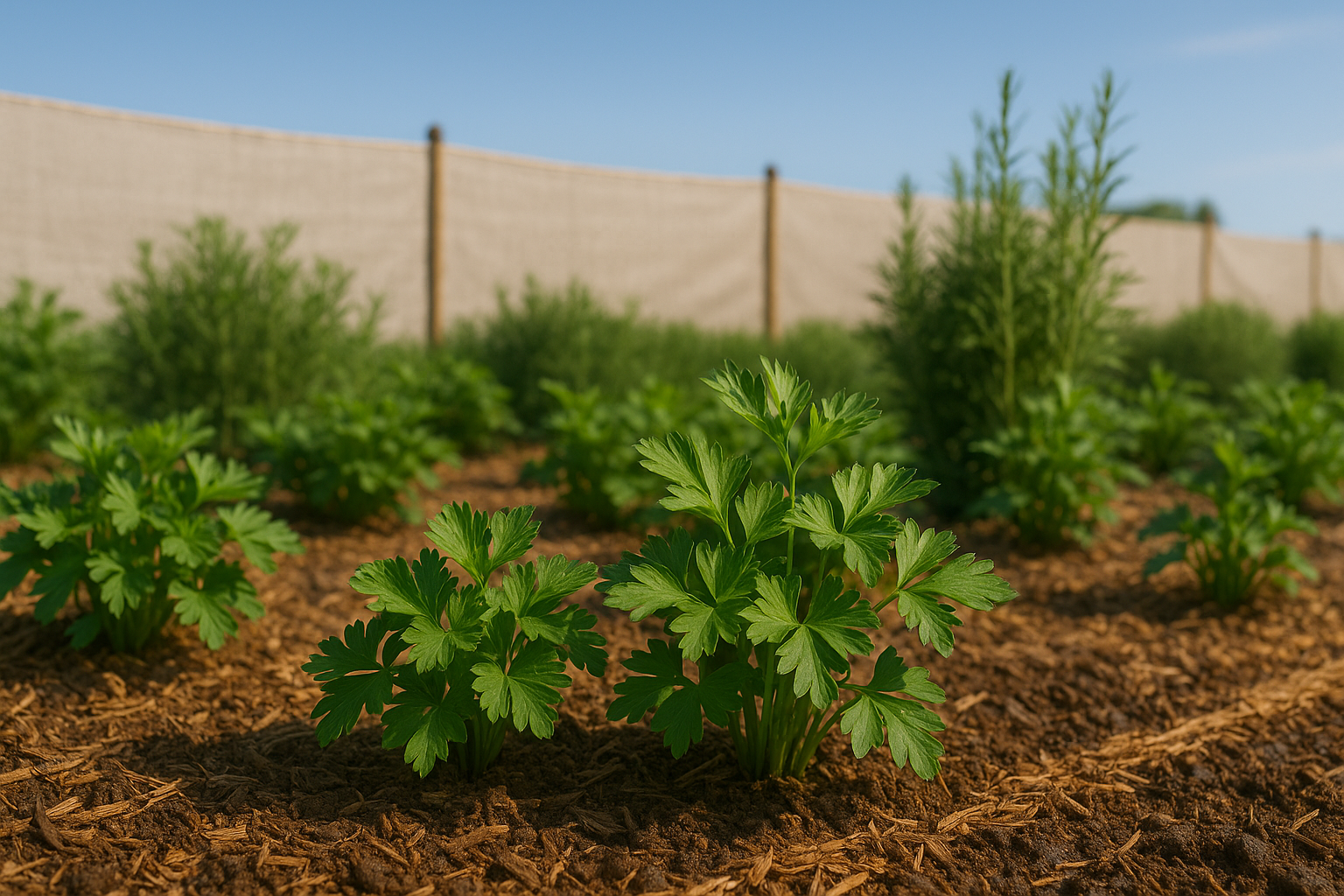
Parsley thrives best in a spot that receives full sun for 6–8 hours a day, though it can tolerate partial shade, especially in hotter climates. Ideally, choose a location with well-drained soil and consistent moisture, as parsley doesn’t like to dry out completely.
Temperature-wise, it prefers a cool range between 50°F and 70°F, making it great for spring and fall planting—though a little mulch can help protect it from surprise frosts or summer heatwaves.
Good airflow is crucial; tightly packed parsley can trap humidity, encouraging fungal diseases like powdery mildew. Plant seedlings or thin sprouts about 6–8 inches apart to keep air moving freely around the leaves.
If your parsley is struggling in a shady, low-ventilation corner, move container plants to a sunnier spot or trim back surrounding overgrowth in the garden. For bedded parsley in a windy or harsh-exposed area, simple windbreaks such as garden fabric, nearby taller herbs, or even a makeshift fence can offer protection.
If sunlight is lacking, try growing parsley on a bright, south-facing windowsill indoors. Regularly check for crowding and thin plants as needed—these small steps ensure healthy, lush parsley with fewer disease problems.
Proactive Care Tips for Healthy Parsley Plants
Keeping your parsley plants healthy and vibrant requires some simple, proactive care. Start with regular watering, making sure the soil stays moist but never soggy—parsley’s roots like consistency.
Spread a layer of organic mulch, such as straw or compost, around your plants to help retain moisture and keep weeds at bay. Every few weeks, feed your parsley with a balanced, all-purpose fertilizer according to the package instructions; this helps replenish nutrients and supports lush growth.
Check your plants often for signs of yellowing leaves, wilting, or pests like aphids—catching issues early makes them much easier to manage. If you notice any old, yellowing, or damaged parsley leaves, snip them off with clean scissors to prevent diseases from spreading.
Harvest sprigs routinely by cutting stems at the base, which not only keeps your parsley bushy but also encourages new, tender shoots. For gardeners in humid areas, ensure parsley has enough airflow by spacing plants properly—this helps prevent fungal problems.
With a little attention each week, your parsley patch will stay healthy, productive, and bursting with flavor all season long.
When to Start Over
If your parsley plants show signs like persistent stunting, yellow or blackened leaves, or a foul smell near the roots, it might be time to start over. Issues such as widespread disease or root rot are often hard to reverse, and lingering problems can stunt or kill new growth.
If you’ve pruned damaged leaves and improved watering but the plant still doesn’t bounce back, it’s a strong sign that the parsley is beyond saving.
Before reaching for new seeds, take the important step of sterilizing your soil. You can do this by baking damp soil in an oven at 180°F (82°C) for 30 minutes or by using organic soil treatments from your local garden center. Clean pots and tools as well to avoid future problems.
Then, start fresh by planting new parsley seeds or buying healthy transplants. This gives your new plants the best chance to thrive in a disease-free environment.
